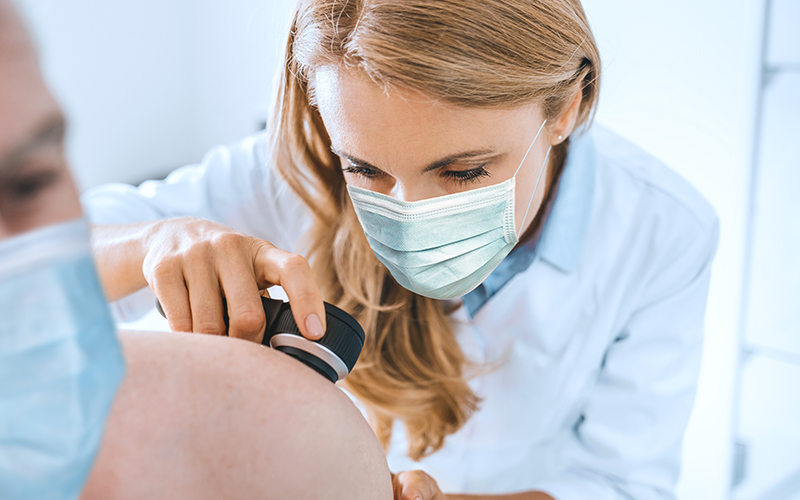
This article was originally published May 2021. It was reviewed May 2024.
by Brian Kumasaka, MD, Dermatology Clinic
Why is it important to regularly check yourself for skin cancer?
Considered the largest organ in the human body, the skin is our first line of defense and greatest protector of our body from heat, light, injury and infection. While melanoma is a type of skin cancer that is not the most common, it’s often responsible for more deaths than other types of skin cancers. It can appear anywhere on the body, even on areas not exposed to the sun. Recognizing the early warning signs of melanoma and doing regular self-examinations of your skin can help find melanoma early, when the disease is more curable.
Screening for early detection
The earlier skin cancer is found, the more successfully it can be treated. Checking your skin regularly is the best way to catch skin cancer early. A doctor specializing in the skin, also known as a dermatologist, can evaluate the patterns of size, shape, and pigmentation of any spots on your skin. They can go through your history and risk factors with you to help decide how often you need a professional skin exam. When you complete your own regular skin exams at home, you’ll become familiar with any spots or moles that you currently have and you’ll know if they change over time. It’s important to note that self-exams do not replace the skin check you’d receive from a skilled dermatologist or provider.
What are you looking for during your self-exam?
Talk with your doctor or a dermatologist if you find a growth on the skin that matches any symptom listed in the ABCDE rule:
- Asymmetry. The shape of one-half of the mole does not match the other.
- Border. The edges of the mole are ragged, notched, uneven or blurred.
- Color. The mole has different colors in it. Shades of black, brown and tan may be present. Areas of white, gray, red or blue may also be seen.
- Diameter. The mole’s diameter is usually larger than 6 millimeters or has grown in size. Six millimeters is about 1/4 inch in diameter, about the size of a pencil eraser. Melanoma may be smaller when it is first detected.
- Evolving. The mole has been changing in size, shape, color or appearance, or it is growing in an area of previously normal skin. Also, when melanoma develops in an existing mole, the texture of the mole may change and become hard or lumpy. The skin lesion may feel different and may itch, ooze or bleed, but a melanoma skin lesion usually does not cause pain.
A sore that does not heal within two weeks.
Six steps to completing your own skin self-exam at home
Self-exams should take place in front of a full-length mirror in a brightly lit room. It helps to have another person check the scalp, back of the neck or any other areas that are hard to see ourselves. Use the ABCDE rule when you’re following these six steps in a self-exam:
- Look at the front and back of the entire body in a mirror, then the right and left sides, with arms raised.
- Bend the elbows and look carefully at the outer and inner forearms, upper arms (especially the hard-to-see back portion) and hands.
- Look at the front, sides, and back of the legs and feet, including the soles and the spaces between the toes.
- Part the hair to lift it and examine the back of the neck and scalp with a hand mirror. Has your hairdresser or barber noticed a suspicious skin area, or lesion, on your scalp or beard?
- Check the back, genital area and buttocks with a hand mirror.
- If you think that certain areas of skin are changing, take photos of the lesion(s) to look for changes over time.
Did you do your skin exam and find something you should have checked by a provider? Or do you want to get started including a professional skin exam in your preventive care? Call for an appointment at Valley’s Dermatology Clinic in Maple Valley 425.690.3581, Newcastle 425.690.3439 or Renton 425.690.3483.
Learn more at valleymed.org/dermatology.
This information adapted from Cancer.Net, content approved by the Cancer.Net Editorial Board, August 2020.

